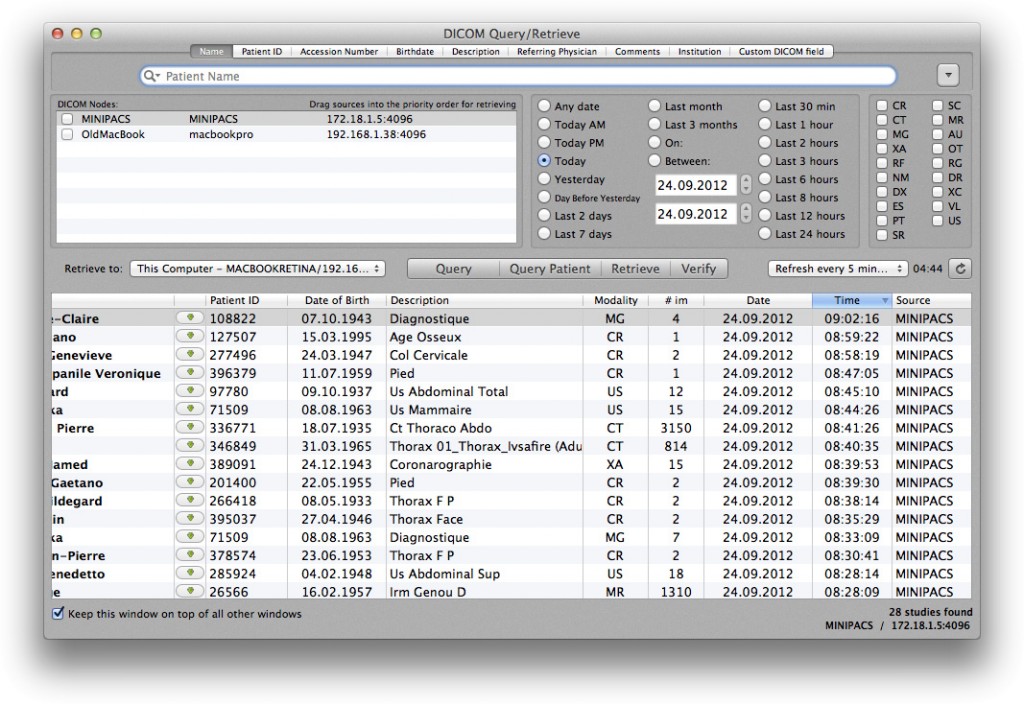
- #FREE DICOM VIEWER QUERY RETRIEVE MANUAL#
- #FREE DICOM VIEWER QUERY RETRIEVE PLUS#
- #FREE DICOM VIEWER QUERY RETRIEVE SERIES#
Set sensor to warning for 3 intervals, then set to down : Set the sensor to the Down status only after the fourth request fails.Set sensor to warning for 2 intervals, then set to down : Set the sensor to the Down status only after the third request fails.If the second request also fails, the sensor shows the Down status. Set sensor to warning for 1 interval, then set to down (recommended) : Set the sensor to the Warning status after the first request fails.Set sensor to down immediately : Set the sensor to the Down status immediately after the first request fails.For previous scanning intervals with failed requests, the sensor shows the Warning status. This can avoid false alarms if the monitored device only has temporary issues.

Depending on the option that you select, the sensor can try to reach and to check a device again several times before the sensor shows the Down status. Select the number of scanning intervals that the sensor has time to reach and to check a device again if a sensor query fails. You can change the available intervals in the system administration of PRTG Network Monitor. The scanning interval determines the amount of time that the sensor waits between two scans. Select a scanning interval from the dropdown list. To change a setting for this object only, click under the corresponding setting name to disable the inheritance and to display its options.įor more information, see section Inheritance of Settings. We recommend that you change them centrally in the root group settings if necessary. However, there is an advanced procedure to do so.īy default, all of the following settings are inherited from objects that are higher in the hierarchy. By default, you cannot exclude single channels from stacking if they use this unit. PRTG stacks all channels with this unit on top of each other. This setting is only visible if you select Stack channels on top of each other as Graph Type.
#FREE DICOM VIEWER QUERY RETRIEVE MANUAL#
You cannot use this option in combination with manual Vertical Axis Scaling in the channel settings. This generates a graph that visualizes the different components of your total traffic. Stack channels on top of each other : Stack channels on top of each other to create a multi-channel graph.Show channels independently (default) : Show a graph for each channel.You can set a different primary channel later by clicking below a channel gauge on the sensor's Overview tab. The available options depend on what channels are available. In the device tree, the last value of the primary channel is always displayed below the sensor's name. Select a channel from the list to define it as the primary channel. Define which field you want to use to name the channels:

This setting is only visible if you select Worklist above. Enter a string that you want to filter for, for example, a station name, station AET, modality, or an asterisk ( * ) to filter for all items. Define a field of the worklist that you want to filter for: Enter a modality in short form that you want to search for, for example, CT, MRI, US, or enter an asterisk ( * ) to search for all modalities.
#FREE DICOM VIEWER QUERY RETRIEVE SERIES#
This setting is only visible if select Study or Series above. Enter a key that you want to search for, for example, an instance Unique Identifier (UID), series UID, patient UID, or enter an asterisk ( * ) to search for all items. This setting is only visible if you select Patient, Study, or Series above. Enter a filter field, a filter string, and a channel field below.

For some sensors, you can explicitly define the monitoring target in the sensor settings.ĭefine the search level of the C-FIND request: Usually, a sensor connects to the IP Address/DNS Name of the parent device. Choose from the lowest priority ( ) to the highest priority ( ). The highest priority is at the top of a list. The priority determines the position of the sensor in lists. The sensor has the following default tags :
#FREE DICOM VIEWER QUERY RETRIEVE PLUS#
It is not possible to enter tags with a leading plus ( +) or minus ( -) sign, or with parentheses ( ()) or angle brackets ( ).įor performance reasons, it can take some minutes until you can filter for new tags. You can use tags to group objects and use tag-filtered views. Confirm each tag with the Spacebar key, the Enter key, or a comma. You cannot change it.Įnter one or more tags. This setting is for your information only. Shows tags that the sensor inherits from its parent device, parent group, and parent probe. Enter a meaningful name to identify the sensor.


 0 kommentar(er)
0 kommentar(er)
